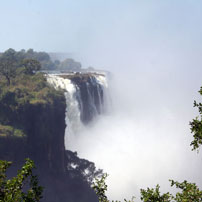 You can imagine my elation when it was decided that it was time for me to do an educational to Zimbabwe – my beloved home! Having worked at Safari Consultants for over thirteen years, I longed for the day that demand for this wonderful country would increase and thus justify a trip. That time had finally arrived and I spent just under two weeks exploring Victoria Falls, Hwange National Park, Lake Kariba, Mana Pools and one night at the end to visit my parents and family home.
You can imagine my elation when it was decided that it was time for me to do an educational to Zimbabwe – my beloved home! Having worked at Safari Consultants for over thirteen years, I longed for the day that demand for this wonderful country would increase and thus justify a trip. That time had finally arrived and I spent just under two weeks exploring Victoria Falls, Hwange National Park, Lake Kariba, Mana Pools and one night at the end to visit my parents and family home.
Touchdown Victoria Falls – the new airport is still under construction but should be completed in early 2016. The airport is certainly a good indication of the increase in tourism and there is talk of direct European flights; all very exciting – we shall see!
The famous Victoria Falls is such an iconic feature of Zimbabwe and not wishing to be biased, but we ‘locals’ do have the best view! I was also impressed with the town. Having visited 10 years ago on holiday, when it was looking rather shabby, I noticed immediately that it had cleaned itself up. I spent a night at the charming Ilala Lodge, which in 2005 looked run-down with few guests and, I have to say, quite pitiful. How different things are today. The hotel was looking impressive with well-kept gardens, a sparkling pool and cheerful staff. With recent continuous high occupancy, they have just completed a brand new wing to keep up with the demand. The hotel was back to life and I was delighted.
My first sundowner was spent enjoying a river cruise on the mighty Zambezi. The boat was the right size to feel personal; the birdlife was good, as was the refreshing ice cold glass of white wine (or was that two?). It is a lovely way to watch your first sunset in Zimbabwe.
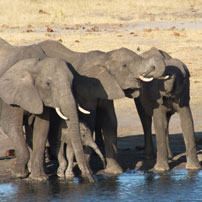 The following morning I travelled by road south-eastwards to Hwange National Park, Zimbabwe’s largest park, covering a 14,600 square kilometres area. The scenery and habitat vary immensely from teak forests, granite hills and mopane woodland in the north to Kalahari Sand-veld in the south, with open grassy plains lined with acacia, islands of Ilala palms, and more mopane woodland in between. The park is famous for large herds of elephants frequenting the manmade waterholes to drink, particularly in the drier months (July to October). Having been extremely fortunate to see fantastic herds of elephant in other parts of Africa, I did not expect to come away topping any of the experiences I had before… How wrong I was!
The following morning I travelled by road south-eastwards to Hwange National Park, Zimbabwe’s largest park, covering a 14,600 square kilometres area. The scenery and habitat vary immensely from teak forests, granite hills and mopane woodland in the north to Kalahari Sand-veld in the south, with open grassy plains lined with acacia, islands of Ilala palms, and more mopane woodland in between. The park is famous for large herds of elephants frequenting the manmade waterholes to drink, particularly in the drier months (July to October). Having been extremely fortunate to see fantastic herds of elephant in other parts of Africa, I did not expect to come away topping any of the experiences I had before… How wrong I was!
The park supports up to 40,000 elephants, almost half the country’s total population, depending on the time of year. The elephant viewing is phenomenal and most of the time you don’t even have to leave the camp! Nearly all properties in Hwange have waterholes with ‘hides’, where you can watch these extraordinary animals at close quarters. You can literally smell their odour and see the imperfections on their leathery, wrinkled skin, and as they take their first satisfying drink, hear the water as it’s sucked up their trunk and sloshed into their mouth.
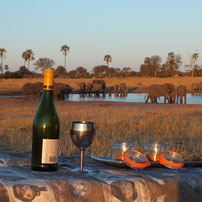 Sundowners are often enjoyed overlooking a waterhole in the bush and I experienced one of my best ever sundowners in Africa. At a safe distance, over the course of an hour and a half, we watched several families stride down to the waterhole to drink. You can’t help but smile and feel their excitement as the young elephants break into a free run, as the smell of the fresh water to their sensitive trunk intensifies with each step they take. The interaction between the various herds, the pecking order between bulls and mutual respect between each other’s family, is fascinating to watch – it was truly magical.
Sundowners are often enjoyed overlooking a waterhole in the bush and I experienced one of my best ever sundowners in Africa. At a safe distance, over the course of an hour and a half, we watched several families stride down to the waterhole to drink. You can’t help but smile and feel their excitement as the young elephants break into a free run, as the smell of the fresh water to their sensitive trunk intensifies with each step they take. The interaction between the various herds, the pecking order between bulls and mutual respect between each other’s family, is fascinating to watch – it was truly magical.
Rewarding wildlife encounters never seem far away in Hwange and I had some superb sable and roan antelope viewing, giraffe, zebra, kudu, hippo, and impala as well as several lions. Overall, I was impressed with the standard of camps visited. Camp Hwange in the north-west is a quality property with superb guiding and an emphasis on wilderness and walking. I spent a night at the Hide Safari Camp, a highlight of your stay here is their underground hide and having the opportunity to sit after dark and watch the elephants drink under starlight, their sounds amplified by the stillness of the night air. To the south east of the park I visited Somalisa, which has recently been rebuilt with new luxury tents, spacious central areas and a fantastic waterhole, visited daily by animals in the drier months. Last and by no means least, I stayed at Davison’s Camp on the private Wilderness Safaris concession: a picturesque concession offering exclusive and good game-viewing. There are three accommodation options, each different in style and comfort. Davison’s was the simplest, but perfectly comfortable with a friendly atmosphere.
I felt sad to leave this park. A friend once said to me Hwange gets under your skin and touches your soul. It certainly did that for me.
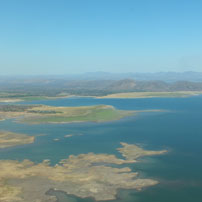 Next stop Lake Kariba. I have fond childhood memories of the lake and it is still one of my favourite places in Africa. I spent many a school holiday here, either with my parents staying at one of the lakeside lodges, or on a friend’s houseboat soaking up the scenery, nature, and of course, fishing!
Next stop Lake Kariba. I have fond childhood memories of the lake and it is still one of my favourite places in Africa. I spent many a school holiday here, either with my parents staying at one of the lakeside lodges, or on a friend’s houseboat soaking up the scenery, nature, and of course, fishing!
Kariba is the largest man-made lake in the world and covers some 5500 sq kms. The Matusadona National Park covers a large proportion of the southern shoreline and vegetation varies from grassland on the upper reaches to woodland on the lower slopes leading to the foreshore. The sunsets on Lake Kariba are unsurpassed!
I spent two nights on the lake, the first at Musango Safari Camp followed by Changa Safari Camp. Both accommodations are markedly different, but equally accommodating. Musango is located on a small island on the western edge of the park, at the mouth of the Ume River. The camp is owner run by renowned guide and charismatic character, Steve Edwards, and his wonderful wife Wendy. The accommodation is simple but comfortable and you feel immediately relaxed in their ‘island home’ and very well looked after by them and their team. Most activities are led by Steve and his knowledge of the lake, its history, archaeology, wildlife and birdlife, is incredible and his sense of humour addictive. Activities include morning and afternoon boat cruises, fantastic for bird-watching, 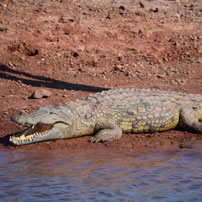 crocodiles and hippos; game drives or rhino tracking in the park and don’t forget the fishing! Back at the lodge enjoy cold drinks, wonderful home cooked food and feel at home. Musango is a real gem.
crocodiles and hippos; game drives or rhino tracking in the park and don’t forget the fishing! Back at the lodge enjoy cold drinks, wonderful home cooked food and feel at home. Musango is a real gem.
Changa Safari Camp is located on the eastern side of the park and offers more luxurious accommodation with delicious food and friendly service. As well as experiencing the variety of activities on offer, the tented lodge is a great place to relax. Why not revel in bit of luxury and enjoy romantic dinners under the stars?
It is worth remembering that Lake Kariba will not compete with Hwange and Mana Pools for wildlife viewing but it will offer a wonderful array of safari experiences. It is a special place of incredible beauty and I believe enhances your overall Zimbabwean experience.
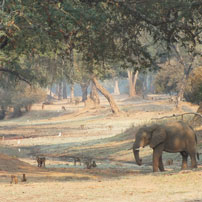 My last stop was Mana Pools. I had longed to visit this park for many years having heard such exciting stories from colleagues and friends. It certainly lived up to my somewhat high expectations. The drive from the airstrip to the first camp alone rendered me speechless. The scenery was captivating. As the surreal light filters through the albida woodlands onto the floodplains of the mighty Zambezi, animals seem to be in each corner of the eye, moving majestically through the trees. I couldn’t help but feel I was in a fairy-tale!
My last stop was Mana Pools. I had longed to visit this park for many years having heard such exciting stories from colleagues and friends. It certainly lived up to my somewhat high expectations. The drive from the airstrip to the first camp alone rendered me speechless. The scenery was captivating. As the surreal light filters through the albida woodlands onto the floodplains of the mighty Zambezi, animals seem to be in each corner of the eye, moving majestically through the trees. I couldn’t help but feel I was in a fairy-tale!
Reality kicked in as I jumped off the vehicle to meet the owner of Goliath Safaris Camp – the renowned, gregarious and rather imposing Stretch Ferreira. Stretch can be an acquired taste: his sense of humour was to ask what I was doing there and how they were not expecting me, only to smile, give me a huge hug and woo me with a few compliments. I knew what an incredible guide (and character) Stretch is, but I don’t think I was quite prepared for the thrilling animal encounters I had in store. Stretch has operated in Mana 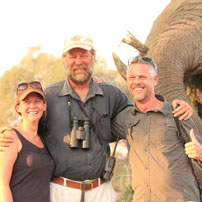 Pools for over 20 years, his knowledge of the park and its wildlife is unrivalled. Walking is a key part of Mana Pools – the open terrain under a canopy of trees affords some wonderful walking and excellent opportunities to get very close to the big game.
Pools for over 20 years, his knowledge of the park and its wildlife is unrivalled. Walking is a key part of Mana Pools – the open terrain under a canopy of trees affords some wonderful walking and excellent opportunities to get very close to the big game.
My first afternoon activity with Stretch found me metres from a bull elephant; my heart pounded profusely as I stood clenching Stretch’s arm. We stood together quietly and watched this magnificent creature happily picking up fallen acacia pods with his enormous trunk with total precision. What an unforgettable experience. The following morning brought more excitement on foot with more elephants, lions, elephant and a hippo out of the water! Throughout all these exhilarating wildlife encounters, although heart pounding at times, I also felt a calmness from being with Stretch. His experience, knowledge of each of the individual animals, but above all, his respect for the animals shines through.
Other camps I visited included African Bush Camps – Kanga Camp located away from the river, but overlooking an enormous pan, namely Kanga Pan, where animals visit daily in the drier months. Even during lunch, I enjoyed watching the antics of baboons drinking and playing and a very happy elephant literally nose dive in the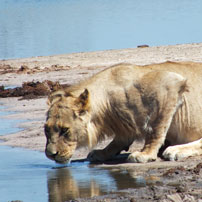 mud! I spent the night back towards the river at their Zambezi Life Styles mobile camp. A wonderful close to nature experience with friendly staff and relaxed atmosphere.
mud! I spent the night back towards the river at their Zambezi Life Styles mobile camp. A wonderful close to nature experience with friendly staff and relaxed atmosphere.
Finally, I spent the night at Vundu Camp on the western edge of the park. Vundu, owner run by Nick Murray and his superb team, has one of my favourite locations in Mana Pools, set under a canopy of riverine trees overlooking the beautiful Zambezi escarpment with the mighty Zambezi River to the fore. Like other camps in Mana, Vundu specialises in walking as well as game-drives. They also offer canoe safaris and mobile canoe trips down the Zambezi. Nick has a passion for wild dogs and a good knowledge of their den sites and movements. Just on the transfer to camp, Nick said to me he had noticed dog prints heading off into the bush. Next minute, we were off on foot, only to find the dogs resting in the shade several minutes later – all part of the Mana Pools adventure.
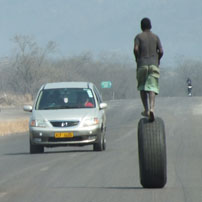 It is hard to summarise this trip. Of course it had sentimental value for me, but I also left with memories of the best and most exciting wildlife encounters I have ever experienced in Africa. Overall, I don’t think parks in Zimbabwe compete with the likes of Kenya’s Masai Mara for sheer numbers and variety of animals, but I do feel the individual areas give you wildlife encounters that are hard to rival. It is ‘old school’ safari, game-viewing can be challenging at times, but combined with the quality guiding, extremely rewarding and incredibly exciting!
It is hard to summarise this trip. Of course it had sentimental value for me, but I also left with memories of the best and most exciting wildlife encounters I have ever experienced in Africa. Overall, I don’t think parks in Zimbabwe compete with the likes of Kenya’s Masai Mara for sheer numbers and variety of animals, but I do feel the individual areas give you wildlife encounters that are hard to rival. It is ‘old school’ safari, game-viewing can be challenging at times, but combined with the quality guiding, extremely rewarding and incredibly exciting!
It is fair to say that whilst the safari industry has ticked over the last 15 years, the competition from neighbouring countries has grown. That said, the country is definitely developing its potential and I could not fault the organisation of transfers and internal flights, everything worked as it should. A highlight is still the guiding. The Zimbabwean guides are extremely well respected within our industry. Their knowledge, passion for the wildlife and environment is a given, and you feel privileged to be guided by them.
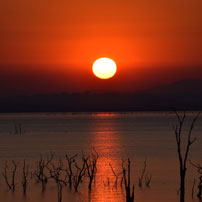 I know many are still hesitant about visiting the country for various understandable reasons. Zimbabwe’s safari industry has fallen on tough times, but most of the safari operators have kept going because of their passion for, and protection of, the wildlife, and that is endearing. By travelling to Zimbabwe, not only are you going to see a beautiful country, meet wonderful people and have unforgettable wildlife experiences, but you will be protecting its precious wildlife and supporting its resilient people.
I know many are still hesitant about visiting the country for various understandable reasons. Zimbabwe’s safari industry has fallen on tough times, but most of the safari operators have kept going because of their passion for, and protection of, the wildlife, and that is endearing. By travelling to Zimbabwe, not only are you going to see a beautiful country, meet wonderful people and have unforgettable wildlife experiences, but you will be protecting its precious wildlife and supporting its resilient people.
